R.J. Stowell's Blog: rjsomeone, page 35
November 13, 2019
My Head is My Only House
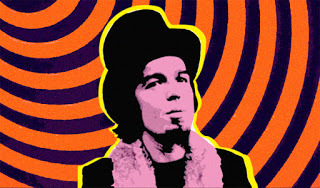 AM was not meant to be collective nostalgia. A loyal follower commented that we'd been stuck in the 50-years-ago theme. There is no doubt of that. And yet, AM's dwelling on the past is misconstrued in that we don't look back so much nostalgically, but as the 60s as being the catalyst for what we still hold near and dear today. The late 60s for this writer are a starting point. Yes, we look back further, but it was the Summer of Love that gave us Sgt. Pepper, The Mothers, The Moodies, Captain Beefheart, The Doors, Cream, Jefferson Airplane and Love. Many of these bands would peak right there in '69, some would capture a sound and run with it, some wouldn't yet hit their stride; among these are the critically acclaimed and often forgotten Captain Beefheart and the Magic Band. Everything about Beefheart points to Trout Mask Replica, but real aficionados reflect more on Lick My Decals Off, Baby as the a more profound statement.
AM was not meant to be collective nostalgia. A loyal follower commented that we'd been stuck in the 50-years-ago theme. There is no doubt of that. And yet, AM's dwelling on the past is misconstrued in that we don't look back so much nostalgically, but as the 60s as being the catalyst for what we still hold near and dear today. The late 60s for this writer are a starting point. Yes, we look back further, but it was the Summer of Love that gave us Sgt. Pepper, The Mothers, The Moodies, Captain Beefheart, The Doors, Cream, Jefferson Airplane and Love. Many of these bands would peak right there in '69, some would capture a sound and run with it, some wouldn't yet hit their stride; among these are the critically acclaimed and often forgotten Captain Beefheart and the Magic Band. Everything about Beefheart points to Trout Mask Replica, but real aficionados reflect more on Lick My Decals Off, Baby as the a more profound statement.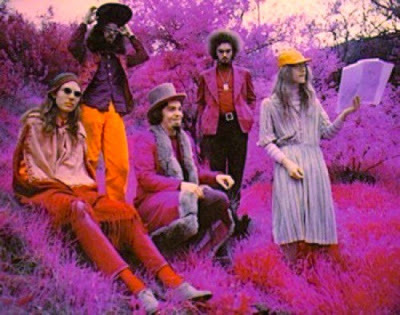 While I'm entranced by both key Beefheart LPs, it's 1972's Clear Spot, superbly produced by Ted Templeman (choirboy lead singer of Harpers Bizarre turned studio wiz), that I go on and on about (so there: 46 years ago instead). And the song that spins over and again in my mind is the seminal "My Head is My Only House Unless it Rains." Listening to, "Dachau Blues," "Pachuco Cadaver" or "Neon Meate Dream of a Octafish" on Captain Beefheart's surreal 1969 masterpiece Trout Mask Replica would hardly incline one to bracket Don van Vliet within the great balladeers. Yet here, barely three years later, he came up with as achingly beautiful a song of love and longing as one could wish to hear. The Magic Band (largely intact from the crazed Trout Mask sessions) are in fine form, featuring the fluid lead guitar of Zoot Horn Rollo (Bill Harkleroad) in counterpoint to rhythm guitarist Rockette Morton (Mark Boston) and bass player Orejón (Roy Estrada). And that's percussionist Ed Marimba (Art Tripp) on, appropriately, the marimba.
While I'm entranced by both key Beefheart LPs, it's 1972's Clear Spot, superbly produced by Ted Templeman (choirboy lead singer of Harpers Bizarre turned studio wiz), that I go on and on about (so there: 46 years ago instead). And the song that spins over and again in my mind is the seminal "My Head is My Only House Unless it Rains." Listening to, "Dachau Blues," "Pachuco Cadaver" or "Neon Meate Dream of a Octafish" on Captain Beefheart's surreal 1969 masterpiece Trout Mask Replica would hardly incline one to bracket Don van Vliet within the great balladeers. Yet here, barely three years later, he came up with as achingly beautiful a song of love and longing as one could wish to hear. The Magic Band (largely intact from the crazed Trout Mask sessions) are in fine form, featuring the fluid lead guitar of Zoot Horn Rollo (Bill Harkleroad) in counterpoint to rhythm guitarist Rockette Morton (Mark Boston) and bass player Orejón (Roy Estrada). And that's percussionist Ed Marimba (Art Tripp) on, appropriately, the marimba.From experience, I can recommend reciting the lyrics to this song at a wedding. "I won't sleep until I find you/ I won't eat until I find you/ My heart won't beat until I wrap my arms around you" – there will not be a dry eye in the house. As much as I've wallowed in the Beefheart version, it's really the cover by the underrated Tubes that rings most true in my ears. Fe Waybill's heart-wrenching rendition was supposedly recorded with the band up on mushrooms, and I can envision that image as a vignette for the song. In it our stoned hero's heart won't beat, he'll take a train or a bus or a plain until he finds her; indeed, the man's head is his only house. The sequence intersperses these lyrics of intense ennui with visions of the lost/estranged love; all in hues of purple and gray. It's what poetry is supposed to be.
If you're a Beefheart fan, but one that's never ventured beyond Trout Mask Replica, listen to "My Head's" tonight with headphones. Not a fan, listen to The Tubes' version – might turn you on to Captain B. Mushrooms, of course, may help as well.
Published on November 13, 2019 04:34
November 12, 2019
November 11, 2019
Days of Future Passed
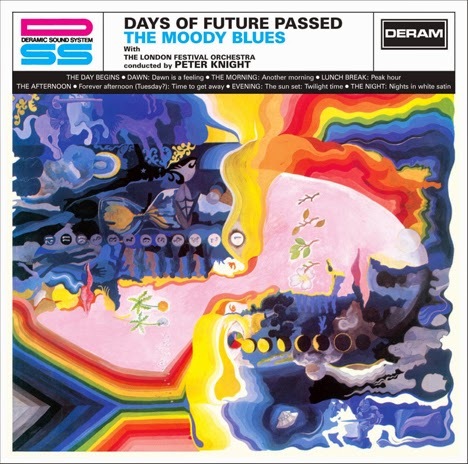 Days of Future Pased (AM9)
Days of Future Pased (AM9)Artist: The Moody Blues
Released: November 11, 1967 (UK) Deram Records, April, 1968 (US) Decca Records
Executive Producer: Hugh Mendl
Recording Engineer: Derek Varnals
Cover painting by: David Anstey
Singles: (UK release dates unless otherwise noted): Nov 10, 1967: Nights In White Satin/Cities; Jul 20, 1968: Tuesday Afternoon (Forever Afternoon)/Another Morning (US release); July 1972: Nights in White Satin (US Re-release).
Personnel: Justin Hayward: Acoustic and electric guitars, piano, keyboards, vocals; John Lodge: Bass, electric guitar, vocals; Mike Pinder: Keyboards, mellotron, piano, vocals; Ray Thomas: Flutes, horns, percussion, keyboards, vocals; Graeme Edge: drums percussion, vocals.
Wait, not in the Rolling Stone top 500? Not in 1001 Albums to Hear Before You Die? Kidding, right? The very first prog album; the first album to utilize a full orchestra; a freakin' overlooked masterpiece, huh?
What appears today as run of the mill (hardly) was ground-breaking in 1967! The idea of fusing psychedelic rock with orchestral arrangements was an improbable marriage. The Moody Blues somehow made it work, before the Beatles, without making it overly-produced or overtly pompous. A true concept album, Days of Future Past is thematic in that it follows a day's activity. As "The Day Begins" Graeme Edge commands the sun to rise. The optimism of the early morning is reflected in Michael Pinder's "Dawn is a Feeling" and in Ray Thomas' "Another Morning". By the afternoon, the recording takes on a surreal quality typical of later psychedelic recordings; indeed, John Lodge's compositions ("Peak Hour", "Forever Afternoon") are truly inspired. Despite the "typical day," the symphonic arrangements with the London Festival Orchestra are far from ordinary.
The optimism fades a bit as the day wears on. The recording closes with Justin Hayward's landmark "Nights In White Satin," which, in a bittersweet way, drains away the early euphoria. Edge recites a "Late Lament" that commands the listener to "Breathe deep the gathering gloom." Really, Rolling Stone? Days of Future Past laid the groundwork for symphonic psychedelia, rock and pop music. Later acts such as King Crimson, Emerson, Lake and Palmer, Procol Harem and the Electric Light Orchestra would follow in the footsteps of this release, as would the Beatles. It was monumental then; it is monumental now and its snub from the Top 500 is a travesty. Madonna's Immaculate Collection, a greatest hits album(!), makes it, Janet Jackson's Rhythm Nation makes it, Big Star? Who the fuck? Twice, no less; but no Days. If you listen to Rhythm Nation before you die, and you haven't listened to this, we at AM are so, so sorry.
Often we report on LPs and events from 50 years ago. This release was 52 years ago, but was such a bomb that it was two years before the LP gained the momentum to go gold. Six years from its release, “Nights in White Satin” would reach the No. 1 spot on the singles charts.
Published on November 11, 2019 04:07
Days of Future Passed
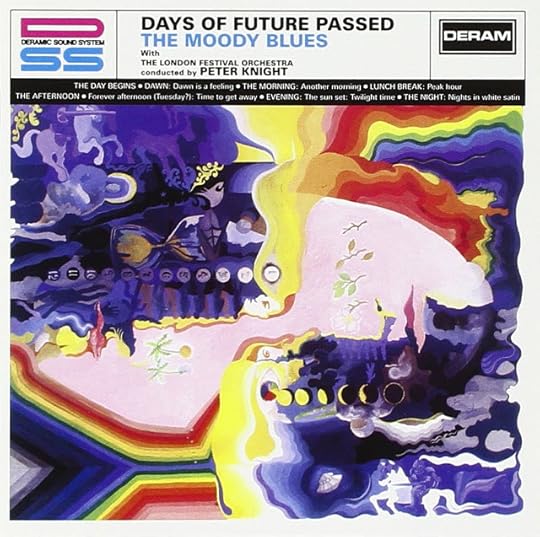 The Beatles' art-rock milestone, Sgt. Pepper, is the LP most closely associated with the Summer of Love in its sound collages and psychedelic undertones, a veritable checklist for everything '67, yet despite its status as the greatest album of all time, what it is not, is evolutionary; instead Sgt. Pepper is a conceptual progression from Revolver. What's truly amazing is that before the end of the year, The Beatles would release the EP, Magical Mystery Tour and the singles "Strawberry Fields," "Hello Goodbye," "Penny Lane," "All You Need is Love" and "Baby, You’re a Rich Man." There is no arguing that 1967 was the year of The Beatles.
The Beatles' art-rock milestone, Sgt. Pepper, is the LP most closely associated with the Summer of Love in its sound collages and psychedelic undertones, a veritable checklist for everything '67, yet despite its status as the greatest album of all time, what it is not, is evolutionary; instead Sgt. Pepper is a conceptual progression from Revolver. What's truly amazing is that before the end of the year, The Beatles would release the EP, Magical Mystery Tour and the singles "Strawberry Fields," "Hello Goodbye," "Penny Lane," "All You Need is Love" and "Baby, You’re a Rich Man." There is no arguing that 1967 was the year of The Beatles.1967 was also the year of Are You Experienced and Disraeli Gears, of Surrealistic Pillowand The Velvet Underground and Nico, but the most influential and impactful release from 1967 (and I am hard-pressed to discount The Velvets) is The Moody Blues' Days of Future Passed.
Commissioned to record a stereophonic rock 'n' roll version of Dvorak's New World Symphony , the band was given a top-notch producer (Tony Clarke), a full orchestra, and conductor/arranger Peter Knight. Though initial sessions went well, there was little heart in the project. With an orchestra on hand, the band were able to convince Clarke and Knight to record the group's own songs. Though Decca was initially appalled that the band would be brash enough to hijack the project, they let it go through. The result was Days of Future Passed, an AM9.
Days of Future Passed (AM9)Artist: The Moody Blues Released: November 11, 1967 (UK) Deram Records, April, 1968 (US) Decca Records Executive Producer: Hugh Mendl Recording Engineer: Derek Varnals Cover painting by: David Anstey Singles: (UK release dates unless otherwise noted): Nov 10, 1967: Nights In White Satin/Cities; Jul 20, 1968: Tuesday Afternoon (Forever Afternoon)/Another Morning (US release); July 1972: Nights in White Satin (US Re-release).Personnel: Justin Hayward: Acoustic and electric guitars, piano, keyboards, vocals; John Lodge: Bass, electric guitar, vocals; Mike Pinder: Keyboards, mellotron, piano, vocals; Ray Thomas: Flutes, horns, percussion, keyboards, vocals; Graeme Edge: drums percussion, vocals.
Wait, not in the Rolling Stone top 500? Not in 1001 Albums to Hear Before You Die? Kidding, right? The very first prog album; the first album to utilize a full orchestra; a freakin' overlooked masterpiece, huh?
What appears today as run of the mill (hardly) was ground-breaking in 1967. The idea of fusing psychedelic rock with orchestral arrangements was an improbable marriage. The Moody Blues somehow made it work, before the Beatles, without making it overly-produced or overtly pompous. A true concept album, Days of Future Passed is thematic in that it follows a day's activity. As "The Day Begins" Graeme Edge commands the sun to rise. The optimism of the early morning is reflected in Michael Pinder's "Dawn is a Feeling" and in Ray Thomas' "Another Morning". By the afternoon, the recording takes on a surreal quality typical of later psychedelic recordings; indeed, John Lodge's compositions ("Peak Hour", "Forever Afternoon") are truly inspired. Despite the "typical day," the symphonic arrangements with the London Festival Orchestra are far from ordinary.
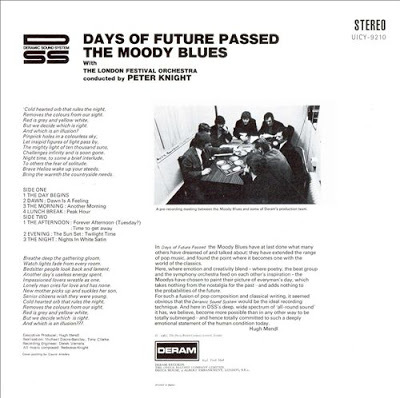 The optimism fades a bit as the day wears on. The recording closes with Justin Hayward's landmark "Nights In White Satin," which, in a bittersweet way, drains away the early euphoria. Edge recites a "Late Lament" that commands the listener to "Breathe deep the gathering gloom." Really, Rolling Stone? Days of Future Passed laid the groundwork for symphonic psychedelia, rock and pop music. Later acts such as King Crimson, Emerson, Lake and Palmer, Procol Harem and the Electric Light Orchestra would follow in the footsteps of this release, as would the Beatles. It was monumental then; it is monumental now and its snub from the Top 500 is a travesty. Madonna's Immaculate Collection, a greatest hits album(!), makes it, Janet Jackson's Rhythm Nation makes it, Big Star? Who the fuck? Twice, no less; but no Days. If you listen to Rhythm Nation before you die, and you haven't listened to this, we at AM are so, so sorry.
The optimism fades a bit as the day wears on. The recording closes with Justin Hayward's landmark "Nights In White Satin," which, in a bittersweet way, drains away the early euphoria. Edge recites a "Late Lament" that commands the listener to "Breathe deep the gathering gloom." Really, Rolling Stone? Days of Future Passed laid the groundwork for symphonic psychedelia, rock and pop music. Later acts such as King Crimson, Emerson, Lake and Palmer, Procol Harem and the Electric Light Orchestra would follow in the footsteps of this release, as would the Beatles. It was monumental then; it is monumental now and its snub from the Top 500 is a travesty. Madonna's Immaculate Collection, a greatest hits album(!), makes it, Janet Jackson's Rhythm Nation makes it, Big Star? Who the fuck? Twice, no less; but no Days. If you listen to Rhythm Nation before you die, and you haven't listened to this, we at AM are so, so sorry.
Published on November 11, 2019 04:05
November 7, 2019
Up Against the Wall, Motherf*#@er - The Woodstock Show
On Tuesday, August 19, 1969, Jefferson Airplane, Joni Mitchell, and David Crosby and Stephen Stills appeared on The Dick Cavett Show. It is now often referred to as "The Woodstock Show," as each of the performers (except Mitchell), and Cavett’s audience, came directly from the concert for the taping the afternoon before the show aired. Stephen Stills pointed out the mud from the concert venue still on his pant leg.
Jefferson Airplane's performance marked the first time the word "fuck" was uttered on television during their latest song, soon to be released as a single from Volunteers, "We Can Be Together."
Joni Mitchell sang "Chelsea Morning," "Willy," "For Free," and "The Fiddle and the Drum," a cappella.
David Crosby, joining the Airplane played "Somebody to Love," and Still performed "4 + 20."
The credits rolled as everybody, aside from Mitchell, participated in an instrumental jam as the audience danced. Jimi Hendrix was scheduled to join the others but was unable to appear at the afternoon taping only a few hours after he performed at Woodstock.
Only 28,000 of the half-million strong saw Jimi, Miles among them.
Published on November 07, 2019 08:47
November 6, 2019
Buried Alive in the Blues
 The LandmarkIn August 1970, Janis Joplin arrived in Los Angeles to begin work on a new album, posthumously titled Pearl. Sessions were planned for Sunset Sound Studios with producer Paul Rothchild, who had worked with The Doors. Joplin checked into the nearby Landmark Motor Hotel (today the Highland Gardens Hotel, 7047 Franklin Avenue, Hollywood). Janis threw herself into the recording sessions and her new album. She even had a bit of fun at the sessions, at one point recording a birthday greeting for John Lennon - “Happy Trails,” the Roy Rogers theme.
The LandmarkIn August 1970, Janis Joplin arrived in Los Angeles to begin work on a new album, posthumously titled Pearl. Sessions were planned for Sunset Sound Studios with producer Paul Rothchild, who had worked with The Doors. Joplin checked into the nearby Landmark Motor Hotel (today the Highland Gardens Hotel, 7047 Franklin Avenue, Hollywood). Janis threw herself into the recording sessions and her new album. She even had a bit of fun at the sessions, at one point recording a birthday greeting for John Lennon - “Happy Trails,” the Roy Rogers theme.
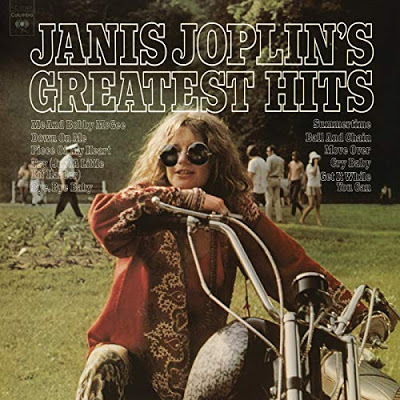 With more than a month's work on the album complete, during which she was the first to arrive in the morning and the last to leave, Janis left the studio on October 3rd with band member Ken Pearson after laying down the vocal for "Me and Bobby McGee." At Barney's Beanery, a roadhouse watering hole that hasn't changed since it opened in 1927, Janis and Pearson knocked back a few drinks and played a game of pool before Janis drove back to the Landmark. Once inside room 105, she shot up her last bag of heroin before wandering into the hotel lobby for cigarettes from a machine. Janis chatted for a few moments with the clerk on duty (he didn't know who she was) and then returned to her room. At some point, she collapsed near the bed from a heroin overdose, ending up wedged against a table, cigarette in hand. When she failed to show up at the next day's recording session, road manager, John Cooke, broke through her door at the Landmark to find the 27-year-old Joplin dead.Four months after her death, in February 1971, the new material was released with the title Pearl, a nickname for Joplin. Pearl topped the album charts for nine weeks, with country song "Me and Bobby McGee," penned by one time lover Kris Kristofferson, sitting in the top spot for the entirety of February, making it the second ever posthumous No. 1 (after Otis Redding's "Sitting on the Dock of the Bay "). The one song on the album without Joplin's vocals - the performance she never made - was included as an instrumental, "Buried Alive in The Blues." Part of its unsung lyrics is telling: "All caught up in a landslide/ Bad luck pressing in from all sides/ Just got knocked off my easy ride/ Buried alive in the blues." As Joplin herself once said: “People, whether they know it or not, like their blues singers miserable. They like their blues singers to die afterwards."
With more than a month's work on the album complete, during which she was the first to arrive in the morning and the last to leave, Janis left the studio on October 3rd with band member Ken Pearson after laying down the vocal for "Me and Bobby McGee." At Barney's Beanery, a roadhouse watering hole that hasn't changed since it opened in 1927, Janis and Pearson knocked back a few drinks and played a game of pool before Janis drove back to the Landmark. Once inside room 105, she shot up her last bag of heroin before wandering into the hotel lobby for cigarettes from a machine. Janis chatted for a few moments with the clerk on duty (he didn't know who she was) and then returned to her room. At some point, she collapsed near the bed from a heroin overdose, ending up wedged against a table, cigarette in hand. When she failed to show up at the next day's recording session, road manager, John Cooke, broke through her door at the Landmark to find the 27-year-old Joplin dead.Four months after her death, in February 1971, the new material was released with the title Pearl, a nickname for Joplin. Pearl topped the album charts for nine weeks, with country song "Me and Bobby McGee," penned by one time lover Kris Kristofferson, sitting in the top spot for the entirety of February, making it the second ever posthumous No. 1 (after Otis Redding's "Sitting on the Dock of the Bay "). The one song on the album without Joplin's vocals - the performance she never made - was included as an instrumental, "Buried Alive in The Blues." Part of its unsung lyrics is telling: "All caught up in a landslide/ Bad luck pressing in from all sides/ Just got knocked off my easy ride/ Buried alive in the blues." As Joplin herself once said: “People, whether they know it or not, like their blues singers miserable. They like their blues singers to die afterwards."
Published on November 06, 2019 09:58
Nuthin'
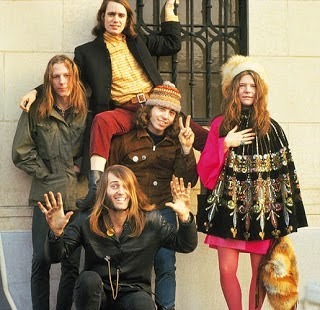 Big Brother and the Holding Company’s Cheap Thrills (AM9) is a 60s' powerhouse raw-blues LP. The band, unfairly referred to at times as Janis Joplin and Some Other People, is the go-to album of blues-rock. From R. Crumb's seminal sleeve to Janis Joplin's vocals to the fuzzed out psychedelia of the band, this is the ultimate acid-experience. The "live" trappings, like those of Sgt. Pepper, are pretense (with the exception of "Ball and Chain," the only purely live experience), but the music has all the fire and spontaneity of a true live recording. For a band that supposedly had no musical talent beyond their lead singer, they sure did make a beautiful racket. "Summertime" is one of the all-time great rock interpretations of a standard; "I Need a Man to Love" has all the soul and power that Aretha Franklin was bringing to a much different idiom around the same time; "Piece of My Heart" has been tamed through commercial exposure, yet it remains an authentically passionate performance and a high-water mark for 60s radio. Cheap Thrills is the perfect document of its time and place, but also, like Memphis in the '50s or London in '77, an enduring testament to the unleashed power of song.
Big Brother and the Holding Company’s Cheap Thrills (AM9) is a 60s' powerhouse raw-blues LP. The band, unfairly referred to at times as Janis Joplin and Some Other People, is the go-to album of blues-rock. From R. Crumb's seminal sleeve to Janis Joplin's vocals to the fuzzed out psychedelia of the band, this is the ultimate acid-experience. The "live" trappings, like those of Sgt. Pepper, are pretense (with the exception of "Ball and Chain," the only purely live experience), but the music has all the fire and spontaneity of a true live recording. For a band that supposedly had no musical talent beyond their lead singer, they sure did make a beautiful racket. "Summertime" is one of the all-time great rock interpretations of a standard; "I Need a Man to Love" has all the soul and power that Aretha Franklin was bringing to a much different idiom around the same time; "Piece of My Heart" has been tamed through commercial exposure, yet it remains an authentically passionate performance and a high-water mark for 60s radio. Cheap Thrills is the perfect document of its time and place, but also, like Memphis in the '50s or London in '77, an enduring testament to the unleashed power of song.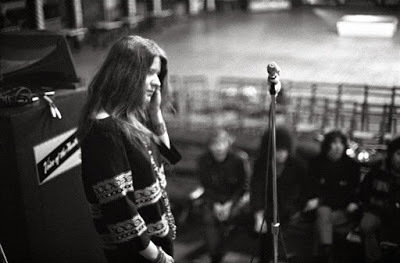 Pearl (AM8) is Janis Joplin’s lush, posthumously released, last hurrah. Stylish, groovingly soulful, soulfully grooving, an unfinished masterpiece, Pearl was Janis Joplin's biggest-selling studio album (though its sales are eclipsed by her greatest hits). One of the most intrinsic and telling moments on Pearl is, frankly, "nuthin'." Joplin’s annunciation of the word is so flat-out REAL that there is no doubt she spoke from the marrow-bone. "My Baby" is gospel-esque and redemptive; as though her voice is a gateway into another realm. What many don't realize is that Janis wrote much of her best material. "Move Over" is a Janis original that she sang on The Dick Cavett Show just before her infamous high school reunion in Port Arthur. She also performed "Get It While You Can" on the same show, as anthemic as any song she recorded; the line, "We may not be here tomorrow," all too prophetic. The instrumental track of the ironic "Buried Alive in the Blues" is rough for all the obvious reasons due to Janis’s conspicuous absence. (She was scheduled to finish the vocals for this Nick Gravenites tune the day she was found dead of an overdose in her motel room.) The juxtaposition of the uptempo beat of "Buried Alive in the Blues" is at odds with the circumstance, yet a fitting tribute and stark reminder that Janis was truly a force of nature and a highly exuberant, joyous personality, even when missing in action.
Pearl (AM8) is Janis Joplin’s lush, posthumously released, last hurrah. Stylish, groovingly soulful, soulfully grooving, an unfinished masterpiece, Pearl was Janis Joplin's biggest-selling studio album (though its sales are eclipsed by her greatest hits). One of the most intrinsic and telling moments on Pearl is, frankly, "nuthin'." Joplin’s annunciation of the word is so flat-out REAL that there is no doubt she spoke from the marrow-bone. "My Baby" is gospel-esque and redemptive; as though her voice is a gateway into another realm. What many don't realize is that Janis wrote much of her best material. "Move Over" is a Janis original that she sang on The Dick Cavett Show just before her infamous high school reunion in Port Arthur. She also performed "Get It While You Can" on the same show, as anthemic as any song she recorded; the line, "We may not be here tomorrow," all too prophetic. The instrumental track of the ironic "Buried Alive in the Blues" is rough for all the obvious reasons due to Janis’s conspicuous absence. (She was scheduled to finish the vocals for this Nick Gravenites tune the day she was found dead of an overdose in her motel room.) The juxtaposition of the uptempo beat of "Buried Alive in the Blues" is at odds with the circumstance, yet a fitting tribute and stark reminder that Janis was truly a force of nature and a highly exuberant, joyous personality, even when missing in action.
Published on November 06, 2019 09:56
"Chelsea Hotel No. 2"
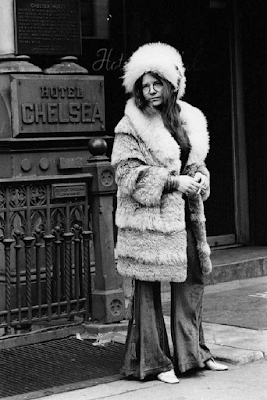 The Chelsea Hotel in Manhattan is where Leonard Cohen lived while in New York in the 1960s. He chose the Chelsea because he knew that there he'd meet people of a similar artistic bent, which he did. The famous Chelsea was the home away from home for the likes of Mark Twain (!), Charles Bukowski, Dylan, Tom Waits and Brendon Urie, to bring it into the modern age. Arthur C. Clarke’s 2001 was written at the Chelsea in early 1964.
The Chelsea Hotel in Manhattan is where Leonard Cohen lived while in New York in the 1960s. He chose the Chelsea because he knew that there he'd meet people of a similar artistic bent, which he did. The famous Chelsea was the home away from home for the likes of Mark Twain (!), Charles Bukowski, Dylan, Tom Waits and Brendon Urie, to bring it into the modern age. Arthur C. Clarke’s 2001 was written at the Chelsea in early 1964. The hotel is memorialized by Cohen in two forms, "Chelsea Hotel No. 1," whose focus and main "character" is the hotel itself, and "Chelsea Hotel No. 2," about Janis Joplin. When introducing this song in concert, Cohen would talk about meeting a famous singer in an elevator of the Chelsea, which led to the sexual encounter described in the song. "I wrote this for an American singer who died a while ago. She used to stay at the Chelsea, too." It's not often that a tribute song contains a description of a blowjob from the deceased (The only other fellatio that I can recall in song is Lou Reed's "Walk On the Wild Side"). Cohen ID's the song's heroine in an interview, but has since expressed regret for exposing Joplin as the subject. While we can't speak for Janis, the depiction of her as a courageous, loving singer captures her independent spirit, and maybe she would have liked the fellatio line.
Chelsea Hotel No. 2
I remember you well in the Chelsea Hotel, you were talking so brave and so sweet, giving me head on the unmade bed, while the limousines wait in the street.
Those were the reasons and that was New York, we were running for the money and the flesh. And that was called love for the workers in song probably still is for those of them left.
Ah but you got away, didn't you babe, you just turned your back on the crowd, you got away, I never once heard you say, I need you, I don't need you, I need you, I don't need you and all of that jiving around.
I remember you well in the Chelsea Hotel you were famous, your heart was a legend. You told me again you preferred handsome men but for me you would make an exception. And clenching your fist for the ones like us who are oppressed by the figures of beauty, you fixed yourself, you said, "Well never mind, we are ugly but we have the music."
I don't mean to suggest that I loved you the best, I can't keep track of each fallen robin. I remember you well in the Chelsea Hotel, that's all, I don't even think of you that often.
Published on November 06, 2019 09:56
Janis
When we think of Lennon, it's with admiration; of Hendrix, reverence; with Morrison, it's conjecture and speculation. Like Cathy Heathcliff in Wuthering Heights, Morrison transcends death; the legend looms so much larger than his 27 years. For others we aren't so steadfastly obliged.
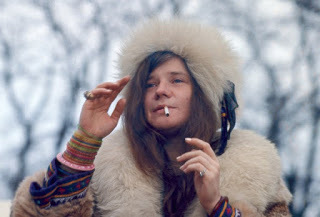 Janis Joplin shared Morrison's California ideology with far less pomp and grandeur, yet she created a legacy equal to that of any 20th-century blues vocalist. From Billy Holiday to Nina Simone, no one captured the gritty sentiment of the blues more effectively than Janis. Big Brother and the Holding Company’s Cheap Thrills (AM9) is a 60s' powerhouse raw-blues LP. The band, unfairly referred to at times as Janis Joplin and Some Other People, is the go-to album of blues-rock. From R. Crumb's seminal sleeve to Janis Joplin's vocals to the fuzzed-out psychedelia of the band, this is the ultimate acid-experience. The "live" trappings, like those of Sgt. Pepper, are pretense (with the exception of "Ball and Chain," the only purely live experience), but the music has all the fire and spontaneity of a true live recording. For a band that supposedly had no musical talent beyond their lead singer, they sure did make a beautiful racket. "Summertime" is one of the all-time great rock interpretations of a standard; "I Need a Man to Love" has all the soul and power that Aretha Franklin was bringing to a much different idiom around the same time; "Piece of My Heart" has been tamed through commercial exposure, yet it remains an authentically passionate performance and a high-water mark for 60s radio. Cheap Thrills is the perfect document of its time and place, but also, like Memphis in the '50s or London in '77, an enduring testament to the unleashed power of song.
Janis Joplin shared Morrison's California ideology with far less pomp and grandeur, yet she created a legacy equal to that of any 20th-century blues vocalist. From Billy Holiday to Nina Simone, no one captured the gritty sentiment of the blues more effectively than Janis. Big Brother and the Holding Company’s Cheap Thrills (AM9) is a 60s' powerhouse raw-blues LP. The band, unfairly referred to at times as Janis Joplin and Some Other People, is the go-to album of blues-rock. From R. Crumb's seminal sleeve to Janis Joplin's vocals to the fuzzed-out psychedelia of the band, this is the ultimate acid-experience. The "live" trappings, like those of Sgt. Pepper, are pretense (with the exception of "Ball and Chain," the only purely live experience), but the music has all the fire and spontaneity of a true live recording. For a band that supposedly had no musical talent beyond their lead singer, they sure did make a beautiful racket. "Summertime" is one of the all-time great rock interpretations of a standard; "I Need a Man to Love" has all the soul and power that Aretha Franklin was bringing to a much different idiom around the same time; "Piece of My Heart" has been tamed through commercial exposure, yet it remains an authentically passionate performance and a high-water mark for 60s radio. Cheap Thrills is the perfect document of its time and place, but also, like Memphis in the '50s or London in '77, an enduring testament to the unleashed power of song.
The band was formed by Peter Albin, Sam Andrew, James Gurley and Chuck Jones in a Victorian mansion/boarding house owned by Peter's uncle at 1090 Page Street in Haight-Ashbury. That house became the site of Wednesday night jam sessions that were organized by Chet Helms who was the real "Big Brother," naming the band, bringing James Gurley into the fold. The band had what Sam Andrew called a "progressive-regressive hurricane blues style."
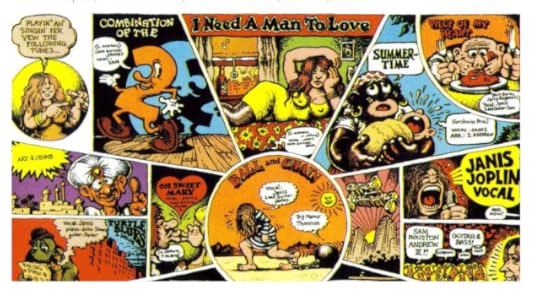 During the winter of '66, Chuck Jones left the band and was replaced by Dave Getz who played his first gig with the band on 12 March at the Matrix on Fillmore Street. Peter Albin was the main vocalist at this time, and although Sam Andrew helped out with the singing, both men knew that the band needed a singer who could match the group's instrumental energies. Chet Helms remembered a friend from his University of Texas days, Janis Joplin, and proposed that he bring her back to San Francisco, where she had tried to launch a singing career in 1963-1964. Janis came to town, sang a couple of tunes with the band at their Henry Street studio, and was enthusiastically welcomed into the group.
During the winter of '66, Chuck Jones left the band and was replaced by Dave Getz who played his first gig with the band on 12 March at the Matrix on Fillmore Street. Peter Albin was the main vocalist at this time, and although Sam Andrew helped out with the singing, both men knew that the band needed a singer who could match the group's instrumental energies. Chet Helms remembered a friend from his University of Texas days, Janis Joplin, and proposed that he bring her back to San Francisco, where she had tried to launch a singing career in 1963-1964. Janis came to town, sang a couple of tunes with the band at their Henry Street studio, and was enthusiastically welcomed into the group.
Big Brother acquired a new manager at Monterey Pop, Albert Grossman, who brought them to Columbia Records where they made their second album, Cheap Thrills, which was No. 1 on the charts for eight weeks. The music on the album was energetic and driving, the perfect match for Joplin's voice. Guitar Player magazine called James Gurley the "Father of the Psychedelic Guitar."
What sets this music apart from other bands of its time was the combination of terrific, brilliantly orchestrated and arranged instrumentals, Joplin's amazing, spectacularly expressive vocals channeling the agony ("I Need a Man To Love") and the ecstasy ("Summertime") of love and life in the bluesiest blues to come out of Texas (by way of San Francisco). The standout are of course, "Piece of My Heart" and the showstopping "Ball and Chain." A little more than a year following Woodstock, like Jimi a month before her, Janis would be gone.
Joplin was born in Port Arthur, Texas, an oil refinery town, in 1943. As a teenager in the late 1950s, she had read about Jack Kerouac and the Beatniks, began to dress in her own style, and started listening to blues music with her few high school friends. Blues singers like Bessie Smith and Leadbelly were among her favorites. Janis soon made her way to California and ended up in San Francisco's music and hippie scene. At Monterey Pop she captured national attention with her incredible performance of "Ball and Chain." From that point on, she became a national phenomenon.
 Janis Joplin shared Morrison's California ideology with far less pomp and grandeur, yet she created a legacy equal to that of any 20th-century blues vocalist. From Billy Holiday to Nina Simone, no one captured the gritty sentiment of the blues more effectively than Janis. Big Brother and the Holding Company’s Cheap Thrills (AM9) is a 60s' powerhouse raw-blues LP. The band, unfairly referred to at times as Janis Joplin and Some Other People, is the go-to album of blues-rock. From R. Crumb's seminal sleeve to Janis Joplin's vocals to the fuzzed-out psychedelia of the band, this is the ultimate acid-experience. The "live" trappings, like those of Sgt. Pepper, are pretense (with the exception of "Ball and Chain," the only purely live experience), but the music has all the fire and spontaneity of a true live recording. For a band that supposedly had no musical talent beyond their lead singer, they sure did make a beautiful racket. "Summertime" is one of the all-time great rock interpretations of a standard; "I Need a Man to Love" has all the soul and power that Aretha Franklin was bringing to a much different idiom around the same time; "Piece of My Heart" has been tamed through commercial exposure, yet it remains an authentically passionate performance and a high-water mark for 60s radio. Cheap Thrills is the perfect document of its time and place, but also, like Memphis in the '50s or London in '77, an enduring testament to the unleashed power of song.
Janis Joplin shared Morrison's California ideology with far less pomp and grandeur, yet she created a legacy equal to that of any 20th-century blues vocalist. From Billy Holiday to Nina Simone, no one captured the gritty sentiment of the blues more effectively than Janis. Big Brother and the Holding Company’s Cheap Thrills (AM9) is a 60s' powerhouse raw-blues LP. The band, unfairly referred to at times as Janis Joplin and Some Other People, is the go-to album of blues-rock. From R. Crumb's seminal sleeve to Janis Joplin's vocals to the fuzzed-out psychedelia of the band, this is the ultimate acid-experience. The "live" trappings, like those of Sgt. Pepper, are pretense (with the exception of "Ball and Chain," the only purely live experience), but the music has all the fire and spontaneity of a true live recording. For a band that supposedly had no musical talent beyond their lead singer, they sure did make a beautiful racket. "Summertime" is one of the all-time great rock interpretations of a standard; "I Need a Man to Love" has all the soul and power that Aretha Franklin was bringing to a much different idiom around the same time; "Piece of My Heart" has been tamed through commercial exposure, yet it remains an authentically passionate performance and a high-water mark for 60s radio. Cheap Thrills is the perfect document of its time and place, but also, like Memphis in the '50s or London in '77, an enduring testament to the unleashed power of song.The band was formed by Peter Albin, Sam Andrew, James Gurley and Chuck Jones in a Victorian mansion/boarding house owned by Peter's uncle at 1090 Page Street in Haight-Ashbury. That house became the site of Wednesday night jam sessions that were organized by Chet Helms who was the real "Big Brother," naming the band, bringing James Gurley into the fold. The band had what Sam Andrew called a "progressive-regressive hurricane blues style."
 During the winter of '66, Chuck Jones left the band and was replaced by Dave Getz who played his first gig with the band on 12 March at the Matrix on Fillmore Street. Peter Albin was the main vocalist at this time, and although Sam Andrew helped out with the singing, both men knew that the band needed a singer who could match the group's instrumental energies. Chet Helms remembered a friend from his University of Texas days, Janis Joplin, and proposed that he bring her back to San Francisco, where she had tried to launch a singing career in 1963-1964. Janis came to town, sang a couple of tunes with the band at their Henry Street studio, and was enthusiastically welcomed into the group.
During the winter of '66, Chuck Jones left the band and was replaced by Dave Getz who played his first gig with the band on 12 March at the Matrix on Fillmore Street. Peter Albin was the main vocalist at this time, and although Sam Andrew helped out with the singing, both men knew that the band needed a singer who could match the group's instrumental energies. Chet Helms remembered a friend from his University of Texas days, Janis Joplin, and proposed that he bring her back to San Francisco, where she had tried to launch a singing career in 1963-1964. Janis came to town, sang a couple of tunes with the band at their Henry Street studio, and was enthusiastically welcomed into the group. Big Brother acquired a new manager at Monterey Pop, Albert Grossman, who brought them to Columbia Records where they made their second album, Cheap Thrills, which was No. 1 on the charts for eight weeks. The music on the album was energetic and driving, the perfect match for Joplin's voice. Guitar Player magazine called James Gurley the "Father of the Psychedelic Guitar."
What sets this music apart from other bands of its time was the combination of terrific, brilliantly orchestrated and arranged instrumentals, Joplin's amazing, spectacularly expressive vocals channeling the agony ("I Need a Man To Love") and the ecstasy ("Summertime") of love and life in the bluesiest blues to come out of Texas (by way of San Francisco). The standout are of course, "Piece of My Heart" and the showstopping "Ball and Chain." A little more than a year following Woodstock, like Jimi a month before her, Janis would be gone.
Joplin was born in Port Arthur, Texas, an oil refinery town, in 1943. As a teenager in the late 1950s, she had read about Jack Kerouac and the Beatniks, began to dress in her own style, and started listening to blues music with her few high school friends. Blues singers like Bessie Smith and Leadbelly were among her favorites. Janis soon made her way to California and ended up in San Francisco's music and hippie scene. At Monterey Pop she captured national attention with her incredible performance of "Ball and Chain." From that point on, she became a national phenomenon.
Published on November 06, 2019 09:54
November 5, 2019
2400 Fulton Street - A Preview of Calif. - The New Novel by R.J. Stowell
 From the Marty Balin Website: "Michelangelo claimed that he did not create a sculpture. Rather, the form was contained within the block of marble; he merely removed the excess, revealing the work of art. 'I feel the same way about music, and about all the projects I’m involved in. The projects do themselves; the music comes through me.' The same vision Marty had when he launched the Jefferson Airplane is present today. In fact, nearly everything he has worked on over the years has been fueled with his vision of art and music as vehicles for expressing a positive message. 'I still have the same attitude. I still love the positive, uplifting songs, and I believe in songs with those qualities. I believe that music can help change the world for the better.'" Marty Balin died on September 27, 2018.
From the Marty Balin Website: "Michelangelo claimed that he did not create a sculpture. Rather, the form was contained within the block of marble; he merely removed the excess, revealing the work of art. 'I feel the same way about music, and about all the projects I’m involved in. The projects do themselves; the music comes through me.' The same vision Marty had when he launched the Jefferson Airplane is present today. In fact, nearly everything he has worked on over the years has been fueled with his vision of art and music as vehicles for expressing a positive message. 'I still have the same attitude. I still love the positive, uplifting songs, and I believe in songs with those qualities. I believe that music can help change the world for the better.'" Marty Balin died on September 27, 2018.The following excerpt is from Calif. R.J. Stowell's novel scheduled for publication in 2020.
1970: I stopped at a light and realized where I was. I'd come out of Golden Gate Park onto Haight Street. There were lots of groovy people, lots of long hairs and head shops and hippies sitting on the curb, and then I passed Ashbury Street and someone in an Econoline panel truck pulled out of a parking space.
I parked the V-dub and did a surprisingly good job. You didn't really parallel park in L.A., pave paradise and all, so I'd never learned. I was singing that the rest of the day. It was a new song by Joni Mitchell and that line about cutting down trees and putting them in a museum was echoing in my head. I grabbed my journal and started walking and taking notes.
A girl passed on the street. She sang, "Don't it always seem to go, you don't know what you've got till it’s gone." She kept walking, and I sang, "Paved paradise, put up a parking lot."
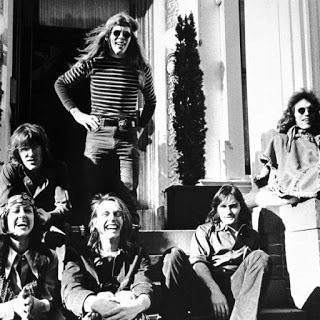 I got down by the park again where there were hippies loitering at 2400 Fulton Street, a big black columnated mansion with date palms out front and a wrought iron gate. It looked like the Haunted Mansion at Disneyland. I asked someone why they were all hanging out. A dude and a girl said simultaneously, almost as if they were one, "It's the Airplane House."
I got down by the park again where there were hippies loitering at 2400 Fulton Street, a big black columnated mansion with date palms out front and a wrought iron gate. It looked like the Haunted Mansion at Disneyland. I asked someone why they were all hanging out. A dude and a girl said simultaneously, almost as if they were one, "It's the Airplane House."I hedged. "Yeah, so, what's the airplane house?" I probably seemed a bit straight to them. I had on chinos, my Chucks, a t-shirt and a Hang Ten windbreaker. I guess, to be honest, and if I were to make an entry in my journal describing myself, I'd end up looking like Jimmy Olsen. In unison they said, "Jefferson Airplane, you know?" They even said "you know" together. "It's 17 rooms and three stories; they say the higher up you get, the higher you get."
I said, "I want to see them. They're playing tomorrow night."
 The guy said, "You got tickets, man?" at the same time the girl said, "You better get a ticket, man." I told them I didn't even know where it was. He said, "The other end of," and she said, "the park."
The guy said, "You got tickets, man?" at the same time the girl said, "You better get a ticket, man." I told them I didn't even know where it was. He said, "The other end of," and she said, "the park."I heard someone point toward an upstairs window and say, "Jorma Kaukonen," but it was a false alarm; it was the wind and a ripple in the glass. It was interesting, this spectacle, but it was kind of odd, like this was the monkey house and the monkeys were hard to spot.
- From the upcoming novel Calif. by R.J. Stowell
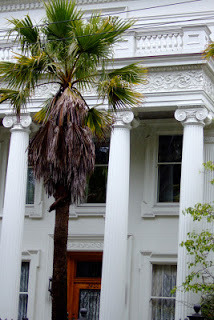 The 17-room mansion at the corner of Willard and Fulton, which lies across the street from Golden Gate Park and just over the western shoulder of Lone Mountain, was bought in May of 1968 by Jefferson Airplane. There aren't many other contenders in the Haight for places where the most LSD has probably been dropped. Called "The Airplane House," "2400 Fulton" (which would become the name of JA's greatest hits LP), or simply "The Mansion" was built in 1904 for a San Francisco lumber baron, the ornate manse became Frisco’s premier party house. Quickly the house would become a magnet for fans, musicians, groupies, dope dealers and celebrities. Part-time girlfriend to "player," Paul Kantner, Barbara Langer said, "I remember one banquet when there was a big fat joint on every plate, and a roasted suckling pig with an apple in its mouth." The Airplane’s manager, Bill Thompson had arranged the sale of the mansion for $70,000 (most recent purchase price nearly $8 million), and hired Jacky Watts to handle the many details. "Thompson sent his girlfriend Judy over to see if I was hip enough. I had a great little house, black light posters all over. I had a kitty car, I was wearing paisley. I passed the hipness test." Thompson gives Jacky all the credit for the find: “The lecherous old guy who lived there liked Jacky. It was the greatest investment we ever made."
The 17-room mansion at the corner of Willard and Fulton, which lies across the street from Golden Gate Park and just over the western shoulder of Lone Mountain, was bought in May of 1968 by Jefferson Airplane. There aren't many other contenders in the Haight for places where the most LSD has probably been dropped. Called "The Airplane House," "2400 Fulton" (which would become the name of JA's greatest hits LP), or simply "The Mansion" was built in 1904 for a San Francisco lumber baron, the ornate manse became Frisco’s premier party house. Quickly the house would become a magnet for fans, musicians, groupies, dope dealers and celebrities. Part-time girlfriend to "player," Paul Kantner, Barbara Langer said, "I remember one banquet when there was a big fat joint on every plate, and a roasted suckling pig with an apple in its mouth." The Airplane’s manager, Bill Thompson had arranged the sale of the mansion for $70,000 (most recent purchase price nearly $8 million), and hired Jacky Watts to handle the many details. "Thompson sent his girlfriend Judy over to see if I was hip enough. I had a great little house, black light posters all over. I had a kitty car, I was wearing paisley. I passed the hipness test." Thompson gives Jacky all the credit for the find: “The lecherous old guy who lived there liked Jacky. It was the greatest investment we ever made."
Published on November 05, 2019 03:24



